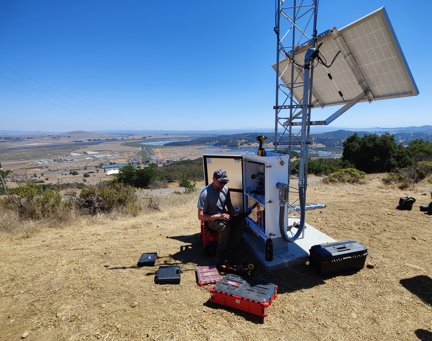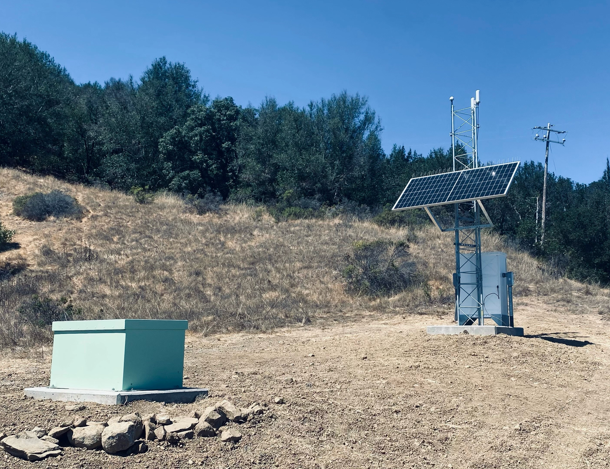by Buck Institute
August 31, 2022 . News
The Buck hosts a “ShakeAlert” seismic station on Mt. Burdell
It’s almost poetic. A biomedical institute that tracks what happens deep in human cells hosts an installation that allows geologists to track what’s happening deep in the earth. In our case, we’re aiming to help mankind by understanding and delaying the aging process. The UC Berkeley Seismology Lab is helping mankind by engaging in essential geophysical research that contributes to an early warning system of earthquakes in Northern California.
 ShakeAlert® is the name of the public earthquake early warning system now being implemented in California, Oregon and Washington. The Buck became part of the system when “our” station was recently installed up on Mt. Burdell.
ShakeAlert® is the name of the public earthquake early warning system now being implemented in California, Oregon and Washington. The Buck became part of the system when “our” station was recently installed up on Mt. Burdell.
To be reliable, ShakeAlert needs a dense network of seismic stations capable of providing real-time data. “Ideally the Bay Area installations need to be within 6.2 miles of each other in order for the system to accurately calculate the expected intensity of ground shaking,” says Jonah Merritt, Field Operations Manager at the Berkeley Seismological Laboratory, who directed the installation on the Buck campus. “The Buck installation helps fill an important gap in our network. We’re grateful that the staff was so willing and excited to work with us.”
ShakeAlert is a collaborative project between UC Berkeley, Caltech, the University of Washington, the University of Oregon, the United States Geological Survey (USGS), and state agencies. Alerts are generated for earthquakes with magnitude 3.5 and greater and shared with licensed operators that then take actions to protect people and assets. Public alerts over licensed cellphone apps are sent for magnitude 4.5 or greater quakes and the Wireless Emergency Alert system pushes out alerts for magnitude 5.0 or greater quakes to phones in the areas of shaking.
The technology works by detecting the first energy to radiate from an earthquake, the primary (P) wave energy, which rarely causes damage. The system estimates the anticipated ground shaking across the region and an alert is delivered to devices that will initiate automated actions before the secondary (S) wave arrives. That’s the wave which brings the strong shaking that usually causes the most damage. BART, the metro/commuter rail system in the San Francisco Bay Area, already uses ShakeAlert to automatically slow trains when an earthquake occurs.
The warning time between the (P) and (S) waves ranges from seconds to tens of seconds, depending on the location of the epicenter of the earthquake. Officials are quick to point out that the warning system is not perfect. For every earthquake, there is a region near the epicenter where alerts will not arrive before shaking begins because the ShakeAlert system needs time to detect the earthquake, issue an alert, and then for US Geological Survey partners to distribute the alert.
Having an installation at the Buck doesn’t give us any advantage when it comes to warnings, which wasn’t a problem at our end. “We wanted to participate for the greater good,” says Mike Madias, Buck’s Facilities and Operations Director who signed the 10-year lease for the project. “We love science. This is science. We were eager to get on board.”
Even a few seconds of warning in an earthquake can be lifesaving, giving people time to take cover away from bookcases, ceiling lights and fixtures. In the 1989 Loma Prieta earthquake, which measured 6.9 on the Richter scale, more than 50% of injuries were linked to non-structural (falling) hazards. ShakeAlert could provide enough time to prevent cars from entering bridges and tunnels. I solating utilities before shaking occurs could reduce the number of fires. The alerts could also allow surgeons to lift scalpels out of patients.
 The installation at the Buck involves two structures. Sensors go nine feet into the ground and are housed in a green box affectionately called “the dog house”. The nearby solar-powered structure receives information from underground and sends signals back to the seismology lab in Berkeley.
The installation at the Buck involves two structures. Sensors go nine feet into the ground and are housed in a green box affectionately called “the dog house”. The nearby solar-powered structure receives information from underground and sends signals back to the seismology lab in Berkeley.
It’s also possible to track what’s happening under the ground at the Buck. This link provides a readout of seismic activity for the previous 24-hour period. Those wanting to go deep into Northern California seismic activity can look at waveforms by station locations. (The Buck’s “address” is BK.BUCI.) Be sure to check out the FAQ’s.
Ordinary citizens can get ShakeAlert-powered alerts sent to their cell phones. There are several ways to get them. The MyShakeTM app was developed by UC Berkeley and is sponsored by the California Governor’s Office of Emergency Services. (Note: The USGS does not directly or indirectly endorse any product or service provided, or to be provided, by these alert delivery providers.)
Science is showing that while chronological aging is inevitable, biological aging is malleable. There's a part of it that you can fight, and we are getting closer and closer to winning that fight.
Eric Verdin, MD, Buck Institute President and CEO